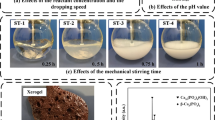Abstract
In this work, Mg2+ doped hydroxyapatite (Mg-HAP) nanoparticles were produced by a reactionprecipitation process by using a spinning disc reactor (SDR) at high rotational speed. The production process of these nanoparticles consisted of the neutralization reaction between two aqueous solutions of calcium chloride and ammonia orthophosphate at room temperature. By operating at pH = 10, a high purity Mg-HAP nanoparticles were obtained. In particular, they were 51 nm in average size when the two reagents were fed over the disc symmetrically at 3 cm from the disc center and a rotational speed of the disc reactor equal to 1400 r/min was adopted.
Similar content being viewed by others
References
Webster T J, Massa-Schlueter E, Smith J, Slamovich E. Osteoblast response to hydroxyapatite doped with divalent and trivalent cations. Biomaterials, 2004, 25(11): 2111–2121
Pina S, Olhero S, Gheduzzi S, Miles A, Ferreira J. Influence of setting liquid composition and liquid-to-powder ratio on properties of a Mg-substituted calcium phosphate cement. Acta Biomaterialia, 2009, 5(4): 1233–1240
Landi E, Logroscino G, Proietti L, Tampieri A, Sandri M, Sipro S. Biomimetic Mg-substituted hydroxyapatite: from synthesis to in vivo behavior. Journal of Materials Science. Materials in Medicine, 2008, 19(1): 239–247
Jahnen-Dechent W, Ketteler M. Magnesium basics. Clinical Kidney Journal, 2012, 5(Suppl 1): i3–i14
Landi E, Tampieri A, Celotti G, Langenati R, Sandri M, Sipro S. Nucleation of hydroxyapatite in synthetic body fluid dense and porous scaffold development: from synthesis to in vivo behavior. Biomaterials, 2005, 26: 2835–2845
Bigi A, Falini G, Foresti E, Gazzano M, Ripamonti A, Roveri N. Magnesium influence on hydroxyapatite crystallization. Journal of Inorganic Biochemistry, 1993, 49(1): 69–78
Gibson I R, Bonfield W. Preparation and characterization of magnesium/carbonate co-substituted hydroxyapatite. Journal of Materials Science. Materials in Medicine, 2002, 13(7): 685–693
Bigi A, Falini G, Foresti E, Gazzano M, Ripamonti A, Roveri N. Rietveld structure refinements of calcium hydroxyapatite containing magnesium. Acta Crystallographica. Section B, Structural Science, 1996, B52(1): 87–92
Correia R N, Magalhanes M C F, Marques P A, Senos A M. Wet synthesis and characterization of modified hydroxyapatite powders. Journal of Materials Science. Materials in Medicine, 1996, 7: 501
Fanovich M A, Castro M S, Porto Lopez J M. Analysis of the microstructural evolution in hydroxyapatite ceramics by electrical characterisation. Ceramics International, 1999, 25(6): 517–522
Bigi A, Marchetti F, Ripamonti A, Roveri N, Foresti E. Magnesium and strontium interaction with carbonate-containing hydroxyapatite in aqueous medium. Journal of Inorganic Biochemistry, 1981, 15(4): 317–327
Adzila S, Ramesh S, Spoyan I, Tan C Y, Hamdi M, Teng W D. Mechanochemical synthesis of magnesium doped hydroxyapatite: Powder characterization. Applied Mechanics and Materials, 2013, 372: 62–65
Ryu H S, Hong K S, Lee J K, Kim D J, Lee J H, Chang B S, Lee D H, Lee C K, Chung S S. Magnesia-doped HA/beta-TCP ceramics and evaluation of their biocompatibility. Biomaterials, 2004, 25(3): 393–401
Tautzenberger A, Kuvtun A, Ignatius A. Nanoparticles and their potential for application in bone. International Journal of Nanomedicine, 2012, 7: 4545–4557
Cafiero L, Chianese A, Jachuck R. Precipitation of barium sulphate using a spinning disk crystallizer. 14th European Symposium on Ind. Crystallization, Cambridge 12–16 Sept. 1999
Baffi G, Cafiero M L, Chianese A, Jachuck R J. Process intensification: Precipitation of barium sulphate using a spinning disc reactor (SDR). Industrial & Engineering Chemistry Research, 2002, 41(21): 5240–5246
de Caprariis B, Di Rita M, Stoller M, Verdone N, Chianese A. Reaction-precipitation by a spinning disc reactor: Influence of hydrodynamics on nanoparticles production. Chemical Engineering Science, 2012, 76: 73–80
Salimi M N, Bridson R H, Grover L M, Leeke G A. Effect of processing conditions on the formation of hydroxyapatite nanoparticles. Powder Technology, 2012, 218: 109–118
Li J, Chen Y P, Yin Y, Yao F, Yao K. Modulation of nanohydroxyapatite size via formation on chitosan-gelatin network film in situ. Biomaterials, 2007, 28(5): 781–790
Landi E, Tampieri A, Mattioli-Belmonte M, Celotti G, Sandri M, Gigante A, Fava P, Biagini G. Biomimetic Mg- and Mg,CO3-substituted hydroxyapatites: Synthesis characterization and in vitro behaviour. Journal of the European Ceramic Society, 2006, 26(13): 2593–2601
Fadeev I V, Shvorneva L I, Barinov S M, Orlovskii V P. Synthesis and structure of magnesium-substituted hydroxyapatite. Inorganic Materials, 2003, 39(9): 947–950
Silverstein R M, Webster F X. KeimLe D J. Spectrometric Identification of Organic Compounds. John Wiley & Sons, 2005, 82–108
Author information
Authors and Affiliations
Corresponding author
Rights and permissions
About this article
Cite this article
D’ Intino, A.F., de Caprariis, B., Santarelli, M.L. et al. Best operating conditions to produce hydroxyapatite nanoparticles by means of a spinning disc reactor. Front. Chem. Sci. Eng. 8, 156–160 (2014). https://doi.org/10.1007/s11705-014-1427-9
Received:
Accepted:
Published:
Issue Date:
DOI: https://doi.org/10.1007/s11705-014-1427-9




